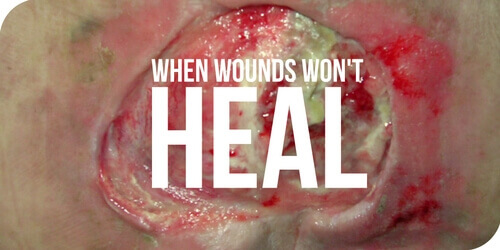Here’s how wound care detectives can solve the mystery of chronic wounds that fail to heal.
Ready for some serious detective work? In this case, our focus is on those chronic wounds that just won’t heal, including epibole (which happens in full thickness wounds). And as we know, this rolled wound edge inhibits healing. But why does this happen with some wounds and not others?
Put on your Wound Detective hat, get out your magnifying glass, and look for the signs and symptoms in your patient’s wound bed, including color, tissue type and odor.
The Mystery
Because full thickness wounds have lost the deep dermis and structures (like the hair follicle and sebaceous glands), epithelialization has to occur from the periphery of the wound edges in and towards the center to close a wound. That movement of the epithelial cells requires a healthy, proliferative wound edge.
Chronic wounds fail to heal as expected due to a multitude of pathologies. Here are some of the signs and symptoms to look for:
- the presence of necrotic tissue
- a prolonged inflammatory stage due to elevated bacteria and proteolytic enzyme levels
- cellular senescence – as there is no fresh bleeding to re-initiate the presence of the healing cascade
- disease co-morbidities
- poor nutritional status
The Clues
In order to solve the mystery of your patient’s wound that just won’t heal, you need to know what to look for. Here are the usual suspects:
Necrotic tissue – debridement of non-viable tissue reduces bacterial burden and development of proteolytic enzymes which keep the inflammation on-going. Debridement facilitates new cell growth by reinitiating the inflammatory process (healing cascade) in senescent cells in the chronic wound.
Dead space – due to the necessity of producing granulation (filler tissue) to fill the “hole” – packing the dead space to absorb debris and exudate will help ensure the epithelial cells won’t migrate down the sides of the wound and form epibole.
Rolled edge – Arrest the development of the new epithelial cells rolling under at the wound rim by wiping the wound edges with gauze during every change of dressing, application of silver nitrate stick, or conservative sharp debridement. The goal is to maintain an acute wound edge.
Senescent cells – Because chronic wounds fail to progress through the usual stages of the wound-healing process, an excessive number of senescent cells (cells that do not replicate or renew in a normal cycle) may restrict cell proliferation and disrupt signaling cascades, thereby retarding the ability of wounds to resolve after injury. Provide stimulation and release the wound from confinement with treatments such as electrical stimulation, negative pressure wound therapy, wound bed pH correction, and collagen and tissue replacement dressings.
Nutritional deficiency – Adequate calories, protein, Vitamin C and A, Zinc, Magnesium, Copper and Iron are crucial in collagen synthesis and development of granulation and epithelial tissue. Arginine and glutamine are amino acids that play an especially important role in wound healing. Help suspend your patient’s chronic-wound mystery by providing these nutrients. In addition, supplemental protein drinks offered frequently through the day and with meds can improve nutrition. It is essential to implement a dietary evaluation and meal planning to support the requirements of healing. A good wound detective investigates the patient’s nutritional status and works with the dietician to elevate nutritional health and capacity to heal.
In these wounds, the goal is to protect and enhance granulation so that:
- the wound fills in appropriately
- epithelial cells migrate across a healthy wound bed to close the wound
- with the maturation and strengthening of the collagen and scar tissue, the wound remains closed and healed
How’s Your Chronic Wound Detective Work?
Have you had success solving the mystery of your patients’ chronic wounds that won’t heal? What types of the usual suspects do you encounter the most? Share your most challenging stories – both the good and bad – by leaving your comments below.
Wound Care Education Institute® provides online and onsite courses in the fields of Skin, Wound, Diabetic and Ostomy Management. Health care professionals who meet the eligibility requirements may sit for the prestigious WCC®, DWC® and OMS national board certification examinations through the National Alliance of Wound Care and Ostomy® (NAWCO®). For more information see wcei.net.
What do you think?

